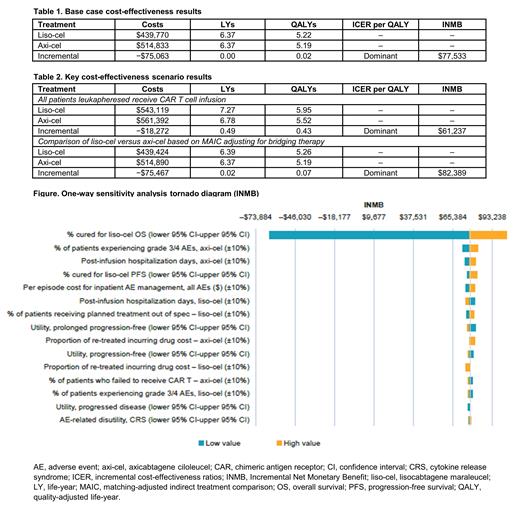Abstract
Background: Patients with R/R LBCL after primary treatment have historically had a poor prognosis and few treatment options. Prior research found that the chimeric antigen receptor (CAR) T cell therapy, axi-cel may be cost-effective in comparison with salvage chemotherapy. Liso-cel, a CD19-directed CAR T cell therapy, may have comparable survival and a better safety profile than axi-cel, representing a valuable treatment option in CD19-directed CAR T cell therapy.
We developed an economic model assessing cost-effectiveness of liso-cel versus axi-cel for patients with R/R LBCL after ≥ 2 lines of therapy from a commercial United States (US) payer perspective.
Methods: Patients entered the model at leukapheresis and were subsequently stratified according to their pre-infusion experience (ie, whether or not they received the CAR T cell infusion due to death or other reasons). The model used a partitioned survival approach to estimate health state occupancy (progression-free survival [PFS], progressive disease, and death) and calculate incremental cost-effectiveness ratios using life-years and quality-adjusted life-years (QALY) over a lifetime horizon.
Survival curves from clinical trials of CAR T cell therapies in R/R LBCL exhibit a plateau, indicating a fraction of patients may achieve durable remission after treatment. Parametric survival models that incorporate cure assumptions or hazards that converge to general population mortality have been widely accepted in R/R LBCL by health technology assessment bodies for CAR T cell therapies. Parametric mixture-cure modeling was used to extrapolate overall survival (OS) and PFS data from TRANSCEND NHL 001 (TRANSCEND [NCT02631044]) for liso-cel and ZUMA-1 (NCT02348216) for axi-cel. Survival of cured patients was modeled per the age- and sex-adjusted general population, adjusted by an excess mortality risk. Survival of non-cured patients was estimated using parametric distributions. Given meaningful differences in the study design, eligibility criteria, and baseline patient characteristics between the two trials, comparative efficacy (OS, PFS) and safety (adverse events [AE]) were estimated using matching-adjusted indirect comparison (MAIC). EQ-5D-5L data from TRANSCEND were used to estimate utilities for health states and AEs. Costs included pretreatment (leukapheresis, bridging therapy, and lymphodepleting chemotherapy), acquisition and administration of CAR T-cell therapies and subsequent-line treatments, all-grade AE management, post-infusion hospitalization, monitoring, and end-of-life care.
Uncertainty was examined using sensitivity and scenario analyses. Scenarios matching TRANSCEND with ZUMA-1 on bridging therapy and assuming all patients received the CAR T cell infusion were also conducted to explore the impact of potential bias resulting from trial design differences.
Results: Following matching and adjustment, the liso-cel effective sample size for indirect comparison was 99 patients. Patients receiving liso-cel achieved improved 5-year survival compared with axi-cel (45% vs 41%, respectively). In the base case, liso-cel dominated axi-cel with nearly equivalent QALYs (0.02) and cost savings of $75,063 (Table 1). The favorable safety profile of liso-cel, including lower rates of cytokine release syndrome and neurological events, was reflected in cost savings (−$35,464) and QALY gains (0.05) when compared with axi-cel. In probabilistic sensitivity analyses, the probability that liso-cel was more effective and less costly than axi-cel was 52% and the probability that liso-cel was cost-effective at a threshold of $100,000 was 78%. Key drivers of cost-effectiveness included the OS cure fraction and the percent of patients experiencing grade 3/4 AEs for axi-cel (Figure). Additionally, 2 scenarios that sought to adjust for differences in trial design both predicted QALY gains and cost savings for liso-cel versus axi-cel (Table 2).
Conclusions: This analysis estimated that liso-cel is cost-effective compared with axi-cel from a commercial US payer perspective, generating similar QALYs at lower cost, partly owing to a favorable safety profile associated with liso-cel.
Parker: Bristol Myers Squibb: Current Employment, Current equity holder in publicly-traded company. Liu: Bristol Myers Squibb: Current Employment, Current equity holder in publicly-traded company. Franco-Villalobos: Bristol Myers Squibb: Consultancy; Other pharmaceutical companies: Consultancy. Proskorovsky: Evidera: Current Employment. Keating: Bristol Myers Squibb: Current Employment, Current equity holder in publicly-traded company.


This feature is available to Subscribers Only
Sign In or Create an Account Close Modal